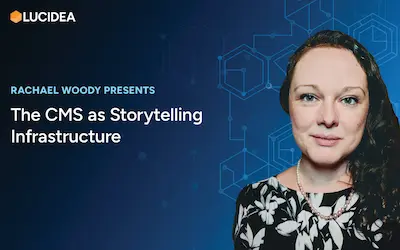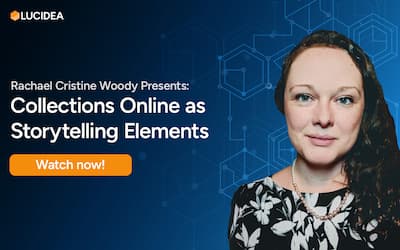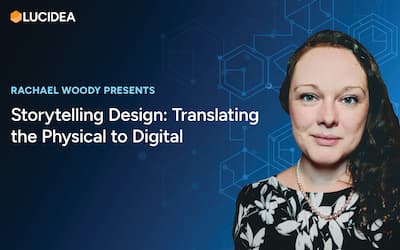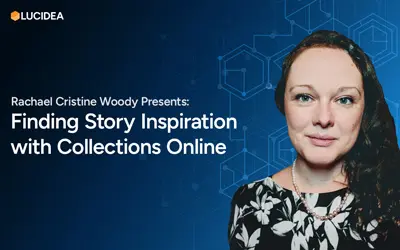The CMS as Storytelling Infrastructure
Read Transcription
Before we start I would like to provide some information about our company and introduce today’s presenter. Lucidea is a software developing company specialized in museum and archival collections management solutions, as well as knowledge management and library automation systems. Our brands include Sydney, Presto, Argus, ArchivEra, Eloquent, and CuadraSTAR.
Now I would like to take a moment to introduce today’s presenter, Rachel Christine Woody. Rachel is the owner of Relicura and provides services to museums, libraries, and archives. She specializes in museum collections management systems, digitization technology, digital project management, and digital usership. During the course of her career, she has successfully launched multiple digital projects that includes advanced digitization technology, collaborative portals, and the migration of collection information into collections management systems. She is also a popular guest author for Lucidea’s Think Clearly blog and has provided us with many great webinars that are listed on our website. So please feel free to check those out after today’s session. Take it away, Rachel.
Thank you so much, Bradley, for that great intro. Thank you to Lucidea for hosting us today, and, of course, you all for joining.
We’re continuing our storytelling conversation, and this particular session is perhaps one of my most favorites because we talk about how the collections management system, the museum CMS, can help serve as a storytelling platform. So if you’re perhaps newer to using collections for storytelling and you perhaps don’t have, a different sort of storytelling software or platform available to you, that’s okay. You don’t necessarily need one, and there’s a few great options with CMS support acting as or supplementing as a storytelling platform.
So we’ll talk about that in a little bit more detail in just a moment. I’ll then introduce, if it’s new to you or a refresher, if you’re familiar with storytelling, in general, we’re gonna talk about pathway types and especially as they pertain to using collections online and using our collections management system. So that’s all to say there can be a variety of additional storytelling pathway types out there and available in different media, but for us we’ll cover the most the most common perhaps for our deployment of storytelling and then we’ll have some examples of each of those pathways so that not only are you learning the concept of the pathway and sort of the hallmarks of that but you’ll also have sense and some online but tangible examples of how that looks when you’re using collections online. So let’s get into it.
So continuing the collections management system, the CMS as storytelling platform, I want to make sure that we’re aware it’s going beyond just the typical object record display.
Of course object records contain a great amount of data. They often now contain digital representations of your artifacts and present it online which is great, but we’re going a step beyond just regular object record display and getting into telling a story which typically involves more than one object and so some of the more traditional ways we’ve done storytelling as museum professionals can be something like putting together exhibitions and when we’re talking about online having those be digital exhibitions so depending on your CMS platform or perhaps the museum website there are a number of ways in which you as the museum are providing and publishing the digital versions of your exhibits or perhaps digital only versions of your exhibits online. So that’s one of the most frequently thought of most frequently used currently ways that we tell stories is through a digital exhibition sort of tool or platform.
And then of course if you don’t have a CMS yet or depending on CMS functionality etcetera you may opt to use your website the museum website or something similar to WordPress for example where you can do website type publishing but have that use your collections management system or catalog or spreadsheet if you don’t have a CMS using that data, using the digital surrogates you have of your objects, and mixing those together to publish online. So the CMS can act as the ingredients so to speak that you can use for your story it can also act as the publishing platform for a digital exhibition type or it can help inform and supplement a different website or like blog post-esque story platform publishing site. So there’s a number of ways you can use the CMS solo hybrid etc.
And it’s a great place to start if you’re new to storytelling and don’t have access to storytelling platforms, which if you’re curious about storytelling platforms, we are gonna talk about those very soon. So make sure you’re checking out the next couple of webinars because we’ll go into the the fun world that that is.
Okay.
Story pathway types.
There are two main pathway types and then a couple ways that those can present. The first one is the linear pathway, and so that one is like one start to end very straightforward way to experience a story.
A multiple pathway sort of storytelling type is that there are several ways to experience the story. There’s not necessarily a, definitive beginning or end, and there’s not necessarily a correct way to experience the story in terms of order. So we’ll take a look at how those show up in a couple different ways with our examples.
And as we’re thinking of the pathway types, there are sort of two flavors. We can experience a pathway and have it be prescriptive.
Prescriptive linear pathways most often go together because not only is linear, the simple straightforward start to end but having it be prescriptive means that there really is no other pathway options or way different ways to experience the story. It’s just the one true way to experience a story.
Then there’s the concept of self determined pathways, and you can have a self determined linear pathway.
That one is perhaps the most complex to understand, so when we get into the examples, it’ll become a little clearer for you, But when you’re on a linear pathway, there’s still that sense of a beginning and end, but you have some options in terms of how you get from the beginning to end.
And then the final or other version of that self determination is when you’re looking at a multiple pathway. So these two are most commonly go together because of course multiple pathway there’s no right or wrong way to experience the story and you’re able to self determine how you experience that story. So all of the options, the way you navigate that pathway or pathways is completely up to you.
So for our example of a prescriptive linear pathway, there are two things to sort of keep in mind as we take a look.
First is that the content can only be explored in one way. So I’ll point out a couple hallmarks of that as we look at the example and there may be an ability to jump areas of content along one way path. So it’s not that we could experience the content in a different order, but there may be an option of like oh I don’t really not really interested in this particular section of the story. I can just scroll past and continue reading so there’s a little bit of flexibility but not much in its presentation.
So for our prescriptive linear pathway example, we are taking a look at the Smithsonian Institution’s National Air and Space Museum.
We are looking at their flight attendants story, which essentially is using their collections management system as sort of like a supplemental force for their digital surrogates their images as well as some of the catalog information and then you’ll see throughout the story as you navigate the the page that there’s a story and descriptive content that helps to weave the narrative using these different digital surrogates of their collection as well as the information and data they have on those objects.
A few things I want to point out here as we look at this example first of which is the identifier of story.
As we’re taking a look at the flight attendants story title we have this little breadcrumb trail where we see we’re in the exploring stories section this is notable because essentially what we’re looking at for us as museum professionals it may look most familiar as a digital exhibit This could very much, if you were to put it in a physical space, serve as a great miniature exhibit.
And for us, we would probably more often than not refer to this as a digital exhibit.
However, given our more general users and given that we are attempting to tell a story with our collections, calling it a story is perhaps more accurate and also more user friendly.
When visitors come to our website or our collections management system the ones who are coming to browse or may have found themselves there through happy accident or exploring they’re there for stories not necessarily for a scholastic deep dive into topics and so using language like story is more inviting.
Another few things to point out for the execution of this story is we’ve got a great header image so we’re getting into like some website user best practices or things that are more user engaging so great visuals having the story title front and center. It’s very obvious what the story is about and we’ve got some attention grabbing description some questions posed to help draw the reader of the story in and then as this story unfolds, it essentially is just scrolling down a web page in terms of the technical aspect and as you scroll down the story continues to unfold with additional description and images.
There’s even some additional supplemental sidebar content if you did want to do a deep dive which as museum professionals we usually do and links to related content which again as museum professionals having those links to the related content having data from our collections management system feed into the presentation of the story hits for us as professionals quite a few tick marks in terms of this is why we present collections online this is how we want to provide access and it’s in a really engageable form and as it is linear and prescriptive, it has got a very definitive beginning to end which is representative of the scrolling from the top to bottom of the story.
There are no alternate ways to experience it. There’s no sort of sub menu of additional deep dive sort of topics or subtopics nothing that would allow the user to experience the story in any sort of different order or way which is not necessarily a bad thing and especially as for those who are newer to presenting stories or digital exhibits in this sort of fashion starting with prescriptive linear pathway can be the easiest to execute correctly and help you build some of your other tools both in terms of the technical aspects of providing access to these digital surrogates and data, as well as the more design and more user friendly aspects of using tools like great visual headers, different sort of sidebar topics to draw people in and just getting familiar with some of the functionality or tools that may be available to you on your storytelling platform.
So, going beyond brief sidebar topics for our self determined linear pathway is one of the hallmarks. So we’re moving from that prescriptive path to our self determinant example.
And if you remember, this is our perhaps our most complex one because it can be self determined yet on a linear path, and that is primarily because we’ve got alternative ways to navigate that linear pathway, and I’ll show you exactly what that means in just one moment.
And it’s important to remember the story is still structured in that linear fashion which is why we’re going to call it a linear pathway instead of a multiple pathway, and most often it is going to have the hallmark of a content menu with sub menu options. So let’s get into it.
Just a couple notes on best practice which we’ll point out as we’re taking a look at our example. When we’re doing a self determined linear pathway first best practice is to include a sense of where the reader is within the story because there’s an ability to hop around and navigate to different places and perhaps a slightly different order.
It can be easy to become disoriented from the story in general. So having a sense of where you are even through a simplistic menu sub menu can be incredibly helpful.
And then second best practice is creating a story where the viewer doesn’t necessarily need to experience the entirety of the content in order to have completed and finish a version of that story.
So because we’ve got that self determinant aspect, we need to make sure that whatever story we construct can still be a completed story in whatever way they navigate and even if they perhaps skip a couple of the story sections.
So let’s see what that looks like in execution.
This is another example from the Smithsonian Institution, but it’s from the National Museum of American History and a couple things to point out as we’re looking at this example.
First of which is we’ve got a past exhibit translated to an online exhibit. So if you joined us for our webinars leading up to this one, you’ll know that we talked about past in person exhibits serving as inspiration and like ready made material for online exhibits or online storytelling. So we’re seeing a great example of that being executed here.
Another hallmark that I want to point out that we just talked about is best practice if is that we have the menu and a sub menu here on this left hand side and as we go through and explore the story content, we can see where we are within this sub menu of the different topics. So we’ve got a great orientation to where we are at as well as what our options are for exploring and navigating the story.
As we go through the menu instead of as in our previous example where it was just a scroll from top to bottom to experience the story we are using the menu to help navigate to the different parts of the content and as we navigate to those different sub menu topics as it were we get a fresh introduction to whatever that particular topic is and of course with a tie into how that topic fits into the larger story that you are telling.
Some other things to think about and note here, we’ve got again, for this first landing page and as you look at each topic, there’s brief but attention grabbing text to help introduce you to it and we’ve also got some great digital surrogate representations of the collection to help pair with that narrative content so pulling not just data but also the digital surrogates from our collections management system in this particular presentation.
This particular example also has some pretty obvious and direct linking to their catalog records so as particular objects are introduced into this particular story there’s the option to go directly to that catalog record to read even more about that particular object and similar to the last exhibition there’s some great use of links to related content so not only as museum professionals are we presenting a story that is engaging our viewers giving them access to different parts of our collection we are then also providing that interlinking of related content to encourage further exploration of our materials.
And then finally a couple other great things about this particular example is part of the exhibit offers discussion prompts so whether deployed in a more traditional classroom type setting or to discuss over dinner with friends you’ve got some great thinking questions to take away with you as you complete the story and if you are an educator there’s even an education section where there are teaching materials that you can pair with this online story to use in your classroom settings so great stuff in terms of both experiencing this particular story as well as things to take away and take with you and carry with you beyond just this experience of a story so great execution on this one.
Alright our final example that we’ll take a look at today in terms of pathways is self determined multiple pathways. So this one is perhaps more common to have together much like with the prescriptive linear pathway. This one is also more typical but it has its own challenges given the multiple pathway concept. So for us multiple pathways means that there are many not just one pathway being offered to experience a story.
Also because there are multiple different pathways, it can be navigated in any direction or order. So there’s no sense of beginning or end. You just jump in and you can go into any direction in any order, which we’ll see in just a moment. An example, the content itself can be experienced to any extent, which is another, perhaps challenge but also great if you execute it properly.
This essentially means that when somebody is experiencing your story, they can experience just a little bit of it and they will have completed the story or they could have experienced all of it and have completed the story. There’s no minimum to the amount of content that the viewer takes in.
Even a small amount is considered a completion of that story, so very interesting creative challenge as well as just like the logistics of delivering a story.
And then, finally, nothing about the pathways are prescribed. So there may be suggestions with different related topics, but ultimately, they are not dictatorial of how the viewer goes through the story.
So this next example is from the Tenement Museum of New York City, which has won several awards, and I believe actually this particular exhibition, if not award winning has been funded by several major funders which in its itself is a gold medal in my book at least and it’s an amazing execution of the self determinant multiple pathways model especially with the idea that you don’t necessarily have to experience more, like, more than just a little bit in order to get the full story. So let me walk you through it. We, of course, have this amazing grid.
We also have some suggested categories relationships of materials popular takes that you could browse and also different sort of superficial collections assigned so there’s some suggestions of ways you could explore the content based on your own interests, but it is not by any means dictating the particular order or navigation of the content. You can also in this example just click on any of these amazing little squares of images to get the stories for those images. So a few different ways you can get into this particular story.
So as we go through its identification, I want to point out similar to our first example is we’re not referring to this as a digital exhibit we are again in this example referring to it as not just a story but stories plural so the concept of delivering this type of content referring to it as a story versus a digital exhibit is a very conscious and perhaps better more accurate way to engage our readers.
We’ve got our multiple points of entry so of course we can click on and into any of these squares as well as across the top the suggested different pathways we could take.
The menu or click tapestry is available So while we don’t necessarily have a menu sub menu for where you are in story, we do have a visual representation of the type of content that we are able to navigate to and in what order it tends to present in.
When we click into these examples we get a story of that particular item but we also get a sense of the object record structure so you’ll see as you look at these particular items for us as museum professionals it can look very familiar like a object record.
This particular one focuses on the story aspect versus just the general metadata for us but you can see very much how CMS can underline and support this type of platform publication.
And then of course our hallmarks you can explore in any order. There’s no wrong way to do it and then you can explore to any extent even if you just clicked on one square and read that one story you would essentially be complete so there’s no sense of needing to read more than one story or complete a particular pathway in order to have received the particular story or stories being conveyed.
So in conclusion, we talked about the collections management system and how it can serve as a publishing platform on its own or serve as supplemental material to a different publishing platform where we are publishing our stories.
We then talked about the different story pathway types, the hallmarks of the linear versus the multiple pathway, and then the two flavors of how we could experience at least the linear pathway going through examples of having it be a prescriptive linear pathway, so start to finish only one right way to experience the story to a self determined linear pathway where we have options.
There’s flexibility around how you start a story, but there’s still a sense of a beginning and an end, and then the sort of beautiful chaos of the self determined multiple pathway where there’s no beginning or end in terms of the right way to start or end nor is there any requirement of the extent or the amount of the story that you consume in order for it to be considered complete.
So with that, we have covered story pathways for our time together today.
Before I let you go, we did talk about the collections management system and of course how the data can help enhance or even, help you sent to our object data for our collections. So as we use our materials, we wanna make sure our data is in great shape. So, the new book demystifying data preparation for a new collections management system, it gives some great advice for data preparation and cleanup just in general, whether or not you’re moving to a new CMS. And then, of course, if you’re shopping for your first CMS or preparing to migrate to a new CMS that hopefully has some great storytelling capabilities, some data preparation and cleanup is always a good idea as you prepare for that journey. So please pick up your free copy courtesy of Lucidea Press.
And with that, I will hand it back over to Bradley.
Thank you, Rachel, for the wonderful presentation and to our audience. If you’d like to learn more about our museum collections management system called Argus, please feel free to visit our website or reach out to us at sales@lucidea.com and we’d be happy to have a chat with you.
And if you have any more questions on any of our software or our company our contact details are listed on the screen and please stay tuned for more webinars and series related to this, content.
On behalf of the Lucidea team, I thank you all for attending today, and until next time. Thank you.



